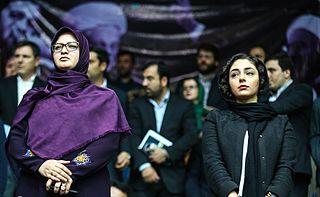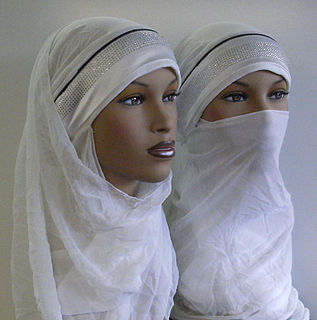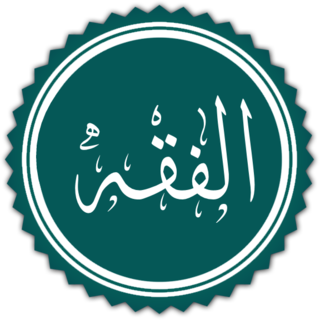
A hijab is a veil worn by certain Muslim women in the presence of any male outside of their immediate family or sometimes by men, which covers the head and chest. Another interpretation can also refer to the seclusion of women from men in the public sphere, whereas a metaphysical dimension, may refer to "the veil which separates man, or the world, from God".

Elizabeth Ann Smart was kidnapped at age fourteen on June 5, 2002, by Brian David Mitchell from her home in the Federal Heights neighborhood of Salt Lake City, Utah. She was held captive by Mitchell and his wife, Wanda Barzee, on the outskirts of Salt Lake City, and later, in San Diego County, California. Her captivity lasted approximately nine months before she was discovered in Sandy, Utah, approximately 18 miles (29 km) from her home.

Anatomy of a Murder is a 1959 American courtroom drama crime film produced and directed by Otto Preminger. The screenplay by Wendell Mayes was based on the 1958 novel of the same name written by Michigan Supreme Court Justice John D. Voelker under the pen name Robert Traver. Voelker based the novel on a 1952 murder case in which he was the defense attorney.

The D.C. sniper attacks were a series of coordinated shootings that occurred during three weeks in October 2002 in the District of Columbia, Maryland, and Virginia. Ten people were killed and three others were critically wounded in the Baltimore–Washington Metropolitan Area and along Interstate 95 in Virginia.

A burqa or burka, also known as a chadaree in Afghanistan or a paranja in Central Asia, is an enveloping outer garment which covers the body and the face that is worn by women in some Islamic and Jewish traditions. The Arab version of the burqa is called the boshiya, and is usually black in color.
Lee Boyd Malvo, also known as John Lee Malvo, is a convicted murderer who, along with John Allen Muhammad, committed a series of murders dubbed the Beltway sniper attacks in the Washington Metropolitan Area over a three-week period in October 2002. Malvo was aged 17 during the span of the shootings. Currently, he is serving multiple life sentences at Red Onion State Prison in Virginia, a supermax prison. Muhammad was executed in 2009.

Islamic clothing is clothing that is interpreted as being in accordance with the teachings of Islam. Muslims wear a wide variety of clothing, which is influenced not only by religious considerations, but also practical, cultural, social, and political factors. In modern times, some Muslims have adopted clothing based on Western traditions, while others wear modern forms of traditional Muslim dress, which over the centuries has typically included long, flowing garments. Besides its practical advantages in the climate of the Middle East, loose-fitting clothing is also generally regarded as conforming to Islamic teachings, which stipulate that body areas which are sexual in nature must be hidden from public view. Traditional dress for Muslim men has typically covered at least the head and the area between the waist and the knees, while traditional women's dress conceals the hair and the body from the ankles to the neck. Some Muslim women also cover their face. Islamic dress is influenced by two scriptural sources, the Quran and hadith. The Quran provides guiding principles believed to have come from God, while the body of hadith describes a human role model through the traditions of the Islamic prophet Muhammad. The branch of fashion industry influenced by Islamic principles is known as Islamic fashion.

A niqāb or niqaab, also called a ruband, is a garment that covers the face, worn by many Muslim women as a part of an interpretation of hijab. The terms niqab and burqa are often confused; a niqab covers the face while leaving the eyes uncovered, while a burqa covers the entire body from the top of the head to the ground, with only a mesh screen allowing the wearer to see in front of her. According to the majority of Muslim scholars and Islamic schools of thought, face veiling is not a requirement of Islam. Those Muslim women who wear the niqab, do so in places where they may encounter non-mahram (un-related) men.
Sultaana Lakiana Myke Freeman is a Muslim American, resident in the state of Florida. She garnered media attention and notoriety when she sued the state of Florida over the right to wear a face veil for her driver's license picture.
The M25 Three were Raphael Rowe, Michael George Davis, and Randolph Egbert Johnson, who were jailed for life at the Old Bailey in March 1990 after being convicted for murder and burglary. The name was taken from the location of the crimes, which were committed around the M25, London's orbital motorway, during the early hours of 16 December 1988. The original trial took place between January and February 1990, resulting in all three being convicted of the murder of Peter Hurburgh, causing grievous bodily harm with intent to Timothy Napier and several robberies. Each was sentenced to life imprisonment for the murder and given substantial sentences for the other offences. The convictions were overturned in July 2000. All three men have consistently maintained their innocence.

The British debate over veils began in October 2006 when the MP and government minister Jack Straw wrote in his local newspaper, the Lancashire Evening Telegraph, that, while he did not want to be "prescriptive", he preferred talking to women who did not wear a niqab as he could see their face, and asked women who were wearing such items to remove them when they spoke to him, making clear that they could decline his request and that a female member of staff was in the room.
Hijab and burka controversies in Europe revolve around the variety of headdresses worn by Muslim women, which have become prominent symbols of the presence of Islam in especially Western Europe. In several countries, the adherence to hijab has led to political controversies and proposals for a legal partial or full ban in some or all circumstances. Some countries already have laws banning the wearing of masks in public, which can be applied to veils that conceal the face. Other countries are debating similar legislation, or have more limited prohibitions. Some of them apply only to face-covering clothing such as the burqa, boushiya, or niqab; some apply to any clothing with an Islamic religious symbolism such as the khimar, a type of headscarf. The issue has different names in different countries, and "the veil" or hijab may be used as general terms for the debate, representing more than just the veil itself, or the concept of modesty embodied in hijab.
Timeline of women's legal rights represents formal changes and reforms regarding women's rights. The changes include actual law reforms as well as other formal changes, such as reforms through new interpretations of laws by precedents. For such things only in the United States, see Timeline of women's legal rights in the United States. The right to vote is exempted from the timeline: for that right, see Timeline of women's suffrage. The timeline excludes ideological changes and events within feminism and antifeminism: for that, see Timeline of feminism.

The word hijab refers to both the head-covering traditionally worn by many Muslim women and to the concept of modesty in Islam generally. Afghanistan and Iran are the only countries where the hijab is compulsory.

Marwa Ali El-Sherbini, was an Egyptian woman and German resident who was killed in 2009 during an appeal hearing at a court of law in Dresden, Germany. She was stabbed by Alex Wiens, an ethnic German immigrant from Russia against whom she had testified in a criminal case for verbal abuse. El-Sherbini's husband, who was present at the hearing, tried to intervene. He too was repeatedly stabbed by Wiens and was then mistakenly shot and wounded by a police officer who was called to the court room. Wiens was arrested at the crime scene and subsequently tried for murder and attempted murder. He was found guilty of both charges; it was also found that Wiens's actions constituted a heinous crime, because they were committed in front of a child, against two people, in a court of law, and fulfilled the murder criterion of treacherousness, such as hatred against foreigners. Wiens was sentenced to life imprisonment.

In a predominantly Muslim society, as many as 90% of women in Egypt have adopted a form of veiling. A majority of Egyptian women cover at least their hair with the hijab. A hijab refers to a head covering that is worn by Muslim women. Although the phenomenon of wearing the niqāb, a veil which covers the face is not as common, the niqab in Egypt has become more prevalent. While a few women in Egypt wear a black niqab along with a billowing black abaya as seen in countries such as Saudi Arabia, many choose to wear different colors of the niqab or manipulate the hijab to cover their face. Regardless, the growing trend of munaqqabat, or women who wear the niqab, has alarmed the authorities. They have begun to see this dress as a security threat, because it hides the face, and because it is perceived as a political statement, a rejection of the state in favor of a strict Islamic system.
Anti-mask or anti-masking laws are legislative or penal initiatives prohibiting the concealment of one's face in public. Anti-mask laws vary widely between jurisdictions in their intent, scope, and penalties.
S.A.S. v. France was a case brought for the European Court of Human Rights which ruled that the French ban on face covering did not violate European Convention on Human Rights's (ECHR) provisions on right to privacy or freedom of religion, nor other invoked provisions. On these two points, the Court held her decision by fifteen votes to two. The two judges in the minority expressed their partly dissenting opinion.

Hijabophobia is a type of religious and cultural discrimination against Muslim women who wear the hijab. The discrimination has had manifestations in public, working and educational places.

The burqa is worn by women in various countries. Some countries have banned it in government offices, schools, or in public places and streets.










